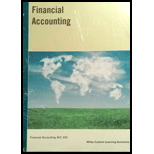
Concept explainers
(a)
Statement of
Statement of cash flow is a financial statement that shows the cash and cash equivalents of a company for a particular period of time. It shows the net changes in cash, by reporting the sources and uses of cash as a result of operating, investing, and financing activities of a company.
Cash flows from operating activities: These refer to the cash received or cash paid in day-to-day operating activities of a company.
Indirect method: Under this method, the following amounts are to be adjusted from the Net Income to calculate the net cash provided from operating activities.
- Deduct increase in current assets.
- Deduct decrease in current liabilities.
- Add decrease in current assets.
- Add the increase in current liability.
- Add
depreciation expense and amortization expense. - Add loss on sale of plant assets.
- Less gain on sale of plant assets.
Cash flow from investing activities: This section of cash flows statement provides information concerning about the purchase and sale of capital assets by the company.
- Deduct the amount of cash used to purchase any fixed assets.
- Add the amount of cash received from sale of any fixed asset.
Cash flow from financing activities: This section of cash flows statement provides information about the
- Add the amount of cash received from any sources of finance.
- Deduct the amount of cash used for payment for dividend and interest from financing activities.
- Deduct the amount of cash used for payment of
treasury stock from financing activities.
To Prepare: Statement of cash flows of W Company using indirect method.
(b)
To Compute: free cash flow of W Company.
Want to see the full answer?
Check out a sample textbook solution
Chapter 12 Solutions
FINANCIAL ACCOUNTING>IC<
- Complete the table given below and compute the WACC from theinformation provided after the table template.arrow_forwardplease help me create a balance sheet and expalin (a) Lisa invested cash by making a deposit in a bank account for the business, $9,000. (b) Paid rent for July, $150. (c) Purchased a used van for cash, $5,000. (d) Purchased a laptop computer (Computer Equipment) on account for, $500. (e) Purchased cleaning supplies that cost $200. Paid $100 cash and will pay the balance next month, $100. (f) Paid part-time assistant (Salaries and Wages expense) for first half of month, $100. (g) Paid for advertising, $90. (h) Paid two-year premium for liability insurance on van, $480. (i) Received cash from clients for services performed, $800. (j) Performed cleaning services for clients on account, $500. (k) Paid phone bill, $40. (l) Received cash from clients for window cleaning performed on account in transaction (j), $200. (m) Paid part-time assistant for last half of month, $200. (n) Made partial payment on computer equipment purchased in transaction (d), $200. (o)…arrow_forwardNeed help in this problem can u doarrow_forward
 Managerial Accounting: The Cornerstone of Busines...AccountingISBN:9781337115773Author:Maryanne M. Mowen, Don R. Hansen, Dan L. HeitgerPublisher:Cengage Learning
Managerial Accounting: The Cornerstone of Busines...AccountingISBN:9781337115773Author:Maryanne M. Mowen, Don R. Hansen, Dan L. HeitgerPublisher:Cengage Learning Managerial AccountingAccountingISBN:9781337912020Author:Carl Warren, Ph.d. Cma William B. TaylerPublisher:South-Western College Pub
Managerial AccountingAccountingISBN:9781337912020Author:Carl Warren, Ph.d. Cma William B. TaylerPublisher:South-Western College Pub Intermediate Accounting: Reporting And AnalysisAccountingISBN:9781337788281Author:James M. Wahlen, Jefferson P. Jones, Donald PagachPublisher:Cengage Learning
Intermediate Accounting: Reporting And AnalysisAccountingISBN:9781337788281Author:James M. Wahlen, Jefferson P. Jones, Donald PagachPublisher:Cengage Learning College Accounting, Chapters 1-27AccountingISBN:9781337794756Author:HEINTZ, James A.Publisher:Cengage Learning,
College Accounting, Chapters 1-27AccountingISBN:9781337794756Author:HEINTZ, James A.Publisher:Cengage Learning, Financial And Managerial AccountingAccountingISBN:9781337902663Author:WARREN, Carl S.Publisher:Cengage Learning,
Financial And Managerial AccountingAccountingISBN:9781337902663Author:WARREN, Carl S.Publisher:Cengage Learning,





